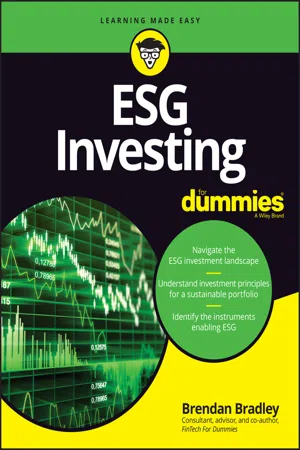IN THIS CHAPTER
Introducing the basic features of the ESG landscape Defining what ESG is and isn’t Looking at ESG’s effects on the environment, society, and governance Using international norms to figure out ESG goals The acronym ESG has undoubtedly become one of the hottest topics in investment management in recent years. Google searches for the term “ESG investing” have grown exponentially in the last three years, so it’s certainly caught people’s attention! (Don’t believe me? Just look at Figure 1-1.) As a result, executive management has a range of new stewardship topics to contend with, now that global warming issues have created ‘E’nvironmental concerns, and the COVID-19 pandemic has further highlighted ‘S’ocial issues. (Corporate ‘G’overnance issues have always been closely monitored by the investment community.)
But what’s all the fuss about? Is ESG investing a passing fad or a long-term trend that will dominate investment management for the foreseeable future? This chapter looks at the fundamentals behind ESG investing, highlights some of the key drivers behind it, and identifies some of the goals and standards that have been established.
Surveying the Current ESG Landscape
Broadly defined as the analysis of a company’s environmental, social, and governance practices, ESG first grabbed the financial world’s attention following a 2005 United Nations Global Compact report, which claimed that incorporating ESG factors into capital markets would make it possible to “do well by doing good.” Since then, the significance of ESG issues has experienced a meteoric rise. The Principles for Responsible Investment (PRI) network of investors, which was introduced in 2006, has grown from 63 asset manager and owner signatories with US$6.5 trillion in assets under management to more than 3,000 signatories with over US$103 trillion in assets under management. Driven by increased stakeholder attention to corporate environmental impacts and investors realizing that strong ESG performance can safeguard a company’s success, ESG is no longer a niche investment concept.
As the world is changing, there is a greater requirement to understand what risks or opportunities a company faces from ESG issues that may determine its long-term prospects. The COVID-19 pandemic has highlighted the need to consider these factors even further, hence the recent surge in investments in this space. Even within this century, the context in which businesses operate has changed radically. Businesses have generally profited from economic growth, globalization, increased consumption, and fossil fuels, and have strengthened and developed their role as the major providers of goods, jobs, and infrastructure worldwide. Consequently, their contribution to essential sustainability issues, such as climate change, biodiversity, social diversity, and inclusion, has also grown. Concurrently, the rise of technology has allowed stakeholders, as well as shareholders, to challenge businesses on how they behave.
Consequently, transparent measurement and disclosure of sustainability performance is now deemed to be an essential part of effective business practices, and a necessity for maintaining trust in business as a force for good. Corporate reporting is a means by which stakeholders, including investors, can identify and measure companies’ performance, just as companies themselves use reporting internally to inform decision-making. Financial reporting has developed as a result of internationally recognized accounting standards that bring transparency, accountability, and competence to financial markets around the world. Therefore, while sustainability disclosure is inevitably more complex than financial reporting, internationally recognized sustainability standards will be the basis for calculating relevant ESG ratings.
Exploring What ESG Is (and Isn’t)
In recent years, the term “ESG” has generally become synonymous with socially responsible investment. However, ESG should be seen as more of a risk management framework for evaluating companies and not as a stand-alone investment strategy. ESG measures the sustainability and societal impact of an investment in a company. These criteria help better determine the future financial performance of companies. Likewise, impact investing is more about the type of investments a manager is targeting, while ESG factors are part of an assessment process to apply non-financial factors to a manager’s analysis in identifying material risks and growth opportunities. Also, impact investing seeks to make a measurable, positive, environmental, or social effect with the investments that a fund manager purchases, whereas ESG is a “means to an end,” serving to identify non-financial risks that may have a material impact on an asset’s value.
Moreover, ESG is often incorrectly commingled with terms such as corporate sustainability and corporate social responsibility (CSR). While some overlap exists, these terms aren’t interchangeable:
- Corporate sustainability is an umbrella term used to describe the long-term creation of stakeholder value by encompassing opportunities and managing risks resulting from economic, environmental, and social developments. To many companies, corporate sustainability is about “doing good” and doesn’t require any set conditions.
- Corporate social responsibility is an embedded management concept where companies incorporate the concerns of key stakeholders into their operations and activities. In comparison, ESG assesses a company’s ESG practices, together with more traditional financial measures.
Finally, ESG is also commonly intermingled with ethical investing. However, taking an ESG approach is effectively a precursor to the point of investing. It provides a framework that allows you to consider ‘E,’ ‘S,’ and ‘G’ issues facing a company and to score them either individually or collectively to identify where they sit relative to each other. This leads investors to consider stocks that may be “best-in-class” from an ESG score perspective or exclude them entirely because, for example, their environmental score doesn’t reflect their values. Ethical investing involves selecting investments based on ethical or moral principles. Such investors typically avoid “sin stocks,” such as those related to gambling, alcohol, or firearms, which can be implemented via an ESG exclusions strategy (where sin stocks are explicitly excluded from a portfolio).
You may be used to gauging financial ratios when investing in stocks, from the relative price-to-earnings (P/E) ratio to EBITDA margins. (Yes, I’m talking about earnings before interest, taxes, depreciation, and amortization — good thing there’s an acronym to use.) All of those ratios are still relevant, but now you can view the same stocks through an additional lens. The sustainability evaluation of ratings firms is normally blended into a single ESG score, similar to the stock recommendations offered by investment banks and brokers. Just as mainstream research analysts calculate different recommendation valuations for the same companies, using largely the same information, so ESG analysts also differ on their recommended scores. Check out
Chapter 2 for an introduction to ESG ratings.
The following sections look at the different components of ESG, including financially material indicators, how those indicators can differ according to industry sector, and how various ESG strategies can be applied across these factors. These elements can be analyzed in the ESG Cube, which represents the intersections between these factors.
Defining the breadth of ESG
Unlike common financial ratios, there aren’t a common set of ratios that neatly define what a good ‘E,’ ‘S,’ or ‘G’ score looks like. And whether you should aggregate the three siblings together or you should consider each one individually depends on your determination of what issues you believe are most relevant from an ESG perspective. Indeed, some of the factors may be more material to some stocks than others. For example, the environmental risks associated with a bank will be less material than those facing a mining company, while such risks may be counterbalanced by more concerns over governance with a bank. Also, to what degree should you be concerned, and what data or methodology will you use to gauge that concern? As you can see, ESG analysis brings an entirely new set of indicators that you need to consider, which can result in a complex analysis that isn’t reasonable for a layperson to calculate.
Of course, investment managers are offering to take all of that hassle away from you and present you with products that incorporate the myriad of factors in different ways. And as the investment world has moved toward passive investment, a number of these products will be index driven. To ensure that you’re familiar with these new products, and that they closely track the performance of established benchmarks, many of the new products will be ESG variations of traditional indexes, such as the S&P 500 or FTSE 100 indexes. So, they represent what you “know and love” with just a few exclusions here, some different weightings there, or a bias or tilt toward or away from given stocks. This should be easy for most investors to comprehend.
Then there is the version for sophisticated investors, including large asset owners such as pension funds and family offices, where that approach won’t pass the “smell test” given the level of fees they are paying for investment management. They expect a much more active management approach, with full consideration of the complex interdependencies that can be analyzed in this process. One way to visualize the approach that an asset manager could take is to consider a matrix, or a three-dimensional cube. An asset owner considers at least three dimensions to be important:
- What are the key industry sectors that exhibit the greatest ESG risks or opportunities?
- Which ESG execution strategy approach should you employ to benefit from this data?
- What are the material ESG components that affect a company’s financial performance?
Welcome to the concept of the ESG Cube, which represents the intersections between these factors. Figure 1-2 illustrates the cube, using three axes: Industry Sectors on the X-axis, ESG Strategies on the Y-axis, and Material Indicators on the Z-axis.
Each of these dimensions can be further categorized, as you find out in the following sections.
Industry sectors
Figure 1-3 expands on the concept by adding the industry sectors utilized in the Sustainability Accounting Standards Board (SASB) Materiality Map:
- Healthcare
- Financials
- Technology and communications
- Non-renewable resources
- Transportation
- Services
- Resource transformation
- Consumption
- Renewable resources and alternative energy
- Infrastructure









